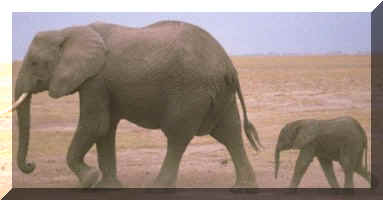

African Elephant
Status: Threatened.
Description: Largest
land mammal on earth with largest brain of any land mammal. Gray-brown thick, but
sensitive skin covered with black, bristly hairs that turn pinkish-white with age.
Fan-shaped ears flap to cool them off. Walk on their toes -- the thick elastic pads on the
bottom of their feet support them. Elephants can run up to 24 miles per hour for short
distances. Excellent swimmers.
Size: Length: Males
are 6-7 meters. Weight: 13,200 pounds. Females are about 2 feet shorter and weigh half as
much.
Habitat: Savanna
grasslands and forests.
Range: Throuhgout
Africa south of the Sahara Desert.
Food Source: Wet season: grasses and leaves from trees and shrubs. Dry season:
woody parts of trees, twigs, branches, and bark, flowers and fruit roots.
Behavior: Home
ranges average 290-620 square miles depending on the abundance of food. Adult males and
females live separately except during the breeding season. Females live in family units
led by the oldest female. Females stay with the family unit, while males live alone or in
small temporary groups after reaching adulthood.
Trunk: The tip of
the trunk has two finger-like lips. Trunk is used for grasping food, as a snorkel while
swimming, for smelling and to spray water or dirt on their backs to cool them off. It has
40,000 muscles and tendons!!
Tusks: First appear
at 2 years of age and continue to grow throughout life reaching an average of 130 pounds
each in males by 60 years of age. Used for peeling bark off trees, digging for roots,
"drilling" for water, herding young and sometimes as a weapon.
Reproduction: Females
carry young for almost 2 years. Give birth during the wet season when more food is
available. At birth, the calf weighs 250 pounds. Young are dependent on the herd until
they reach 10 years. A cow may give birth every 3-4 years.
Population: 400,000-600,000.
Longevity: 50-60
years.
Survival Threats: Habitat
loss because of increasing human populations, ivory trade, drought.
Legal Protection: CITES,
Appendix I, African Elephant Conservation Act, Endangered Species Act.
Conservation: Banning
of ivory trade, public education, creation of national parks to control poaching and
ensure water source.
